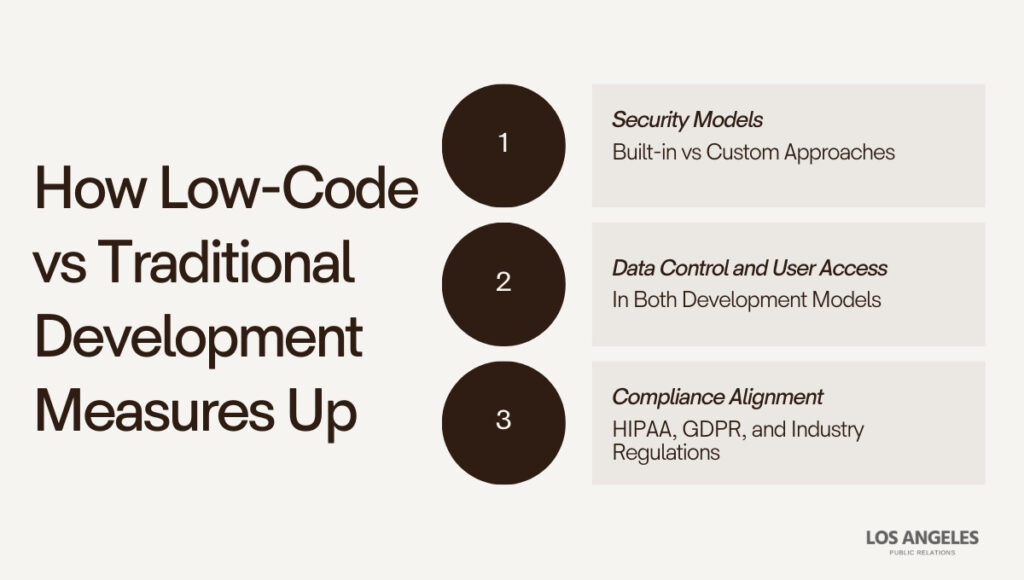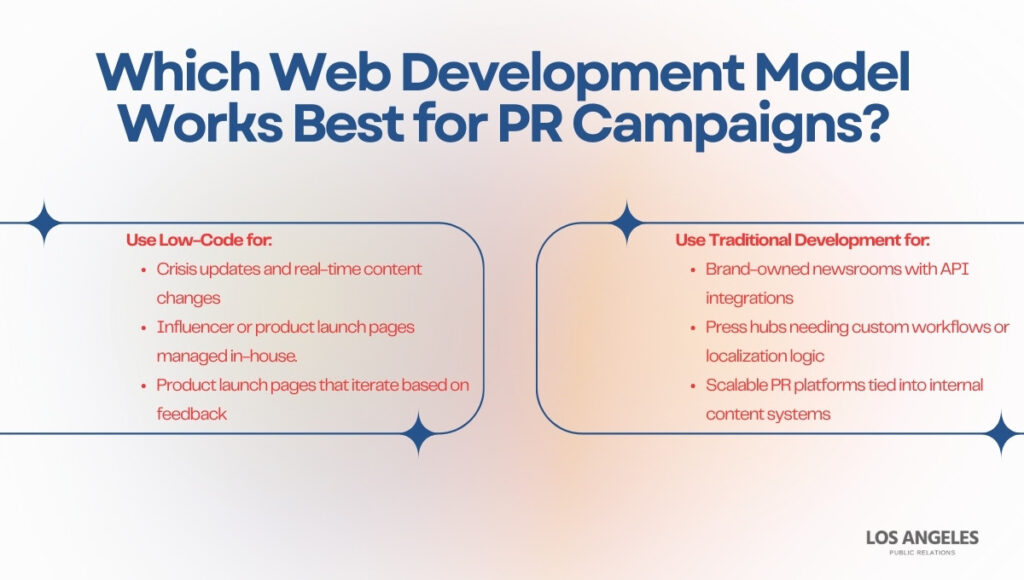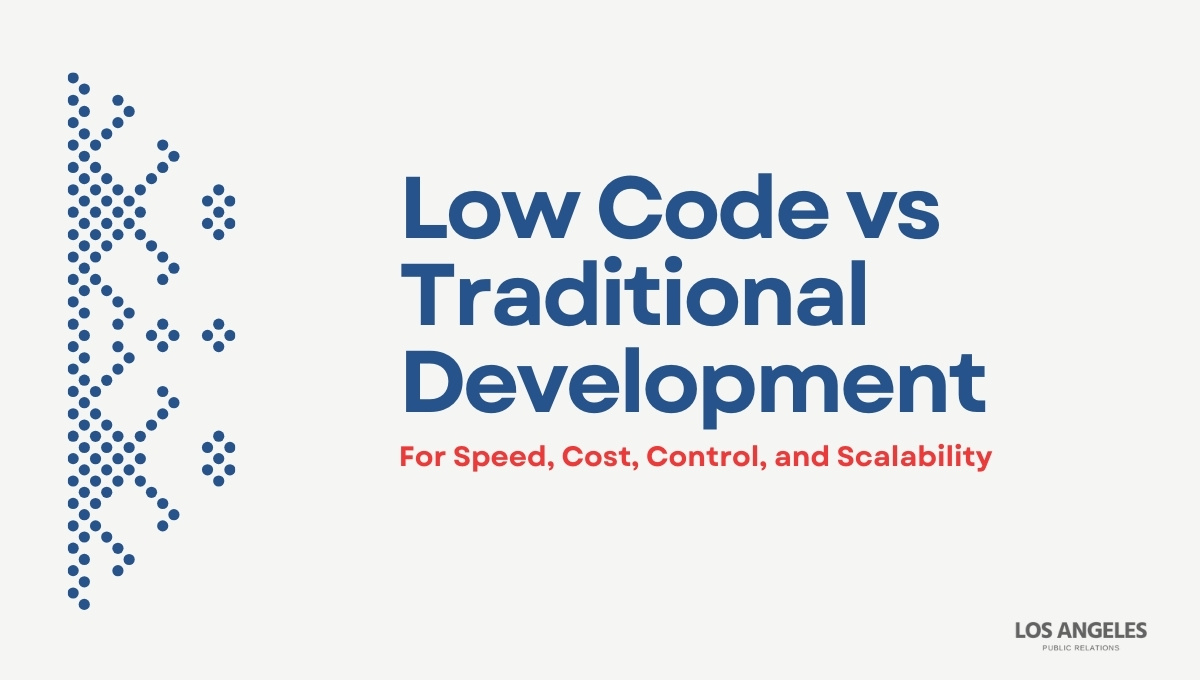For business leaders, quick website launches and efficient development cycles are key to driving growth and maintaining brand visibility. By optimizing development processes, businesses can save time, reduce costs, and stay ahead in an ever-evolving market.
Low-code and traditional development offer unique advantages. Low-code platforms deliver rapid deployment with intuitive workflows, allowing businesses to move fast without compromising flexibility. Traditional development, meanwhile, offers robust customization, making it ideal for brands with specific, complex needs.
With over 20 years of experience, LAPR empowers brands to strategically align their tech stacks with growth objectives, campaign timelines, and scalable success.
Table of Contents
ToggleWhat Are the Key Differences Between Low Code and Traditional Development?
The key difference between low-code and traditional development lies in speed, control, and infrastructure. Each approach affects your system architecture, deployment flexibility, workflow autonomy, and iteration pace. These factors directly impact how quickly your brand can scale, adapt content, and respond to high-velocity campaigns.
Definition and Key Features of Low-Code Development
Low-code development is a visual, component-based approach that minimizes manual coding by utilizing drag-and-drop interfaces, reusable elements, and built-in automation. It empowers non-technical users and small teams to efficiently create and manage digital products, cutting down on engineering resources.
Popular platforms like Webflow, OutSystems, and Mendix offer scalable UI components, native hosting, and seamless third-party integrations.
Key Features:
- Visual Development: Drag-and-drop builders enable marketers and designers to create entire websites without needing to write code.
- Reusable Components: Pre-built elements ensure consistency and faster development cycles.
- Workflow Automation: Automates tasks such as form handling, CMS updates, and lead routing with no coding required.
- Platform Integrations: Easily connects with tools like Zapier, HubSpot, and Google Analytics.
- Reduced Code Footprint: Simplifies debugging and fosters better collaboration between technical and non-technical teams.
- Low Technical Barrier: Allows marketers and PR teams to update content without developer assistance.
Definition and Core Principles of Traditional Development
Traditional development involves the manual creation of digital platforms using code-based tools, prioritizing control, scalability, and customization. It relies on developer-written code and open-source frameworks to craft high-performance systems that are precisely tailored to meet business needs.
Core Principles:
- Manual Coding: Built with HTML, CSS, JavaScript, and frameworks such as React, Laravel, Node.js, and Django.
- Source Code Ownership: Provides full control over the codebase and intellectual property (IP).
- Deployment Flexibility: Allows for modular, enterprise-grade customization.
- High-Code Environment: Offers in-depth control over APIs, databases, and user roles.
- Backend Control: Perfect for eCommerce platforms, CRMs, portals, and large-scale systems.
Comparing Speed, Cost, and Control Between Low-Code and Traditional Development
| Factor | Low-Code | Traditional Development |
| Time-To-Launch | 2-4 weeks | 2-3 months or more |
| Upfront Cost | $5,000–$20,000 | $25,000–$100,000+ |
| Long-term Maintenance | Minimal; platform-managed | Ongoing dev support or retainer |
| Customizability | Limited by platform constraints | Full stack-level customization |
| Developer Requirements | Low (designers, marketers) | High (engineers, product managers) |
Low-code platforms deliver faster ROI (returns on investment) and lower costs, making them ideal for businesses prioritizing speed and affordability. However, they offer less flexibility in customization.
Traditional development, while requiring more time and budget, allows for complete control over customization and scalability. The choice between low-code and traditional development hinges on whether you prioritize speed and cost or the ability to fine-tune and scale your digital infrastructure.
Which Development Model Supports Business Growth Better?
The ideal web development approach aligns with your growth objectives. Low-code is perfect for brands that prioritize speed and agility, enabling rapid launches and quick PR impact. Traditional development, on the other hand, excels for businesses that require complete control, customization, and long-term scalability. The right development model should seamlessly integrate with your campaign timelines, digital strategy, and internal resources, empowering your brand to grow and adapt effectively.
Use Cases: When Low-Code Shines for PR, Marketing & Microsites
Low-code platforms offer unmatched speed, autonomy, and flexibility, making them the perfect choice for marketing websites and time-sensitive campaigns. With these solutions, non-technical teams can quickly iterate and deploy digital assets without relying heavily on developers.
Ideal Campaign Use Cases:
- Product Launch Microsites: Quickly built with SEO-optimized templates on platforms like Webflow or Squarespace for fast go-to-market execution.
- Influencer & Ambassador Hubs: Create visually engaging pages that are easy to replicate and update without needing developer support.
- Event or Seasonal Landing Pages: Launch within days, with built-in forms, calendars, and tracking tools, perfect for campaigns with tight deadlines.
- Crisis Management Sites: Enable real-time updates that can be published by PR teams instantly, with no engineering involvement.
Teams using low-code for marketing websites report up to 80% faster deployment and a significant reduction in developer reliance, according to Webflow benchmarks. This speed and efficiency allow brands to stay agile and responsive, particularly in fast-moving PR and marketing campaigns.
When Traditional Coding is the Best Choice for Advanced, High-Performance Solutions
Traditional coding is the cornerstone for building sophisticated systems that require full control over architecture, data flow, and integrations. It is the preferred solution for enterprise-grade web development, offering custom logic, secure user roles, and seamless API-driven workflows.
Ideal Use Cases:
- eCommerce Platforms: Custom checkout flows, inventory synchronization, and personalized shopping experiences.
- Client Portals: Secure, permission-based access with tailored user experiences.
- CRM Dashboards: Dynamic, API-driven data for real-time insights and analytics.
In industries like fintech, healthtech, and logistics – where compliance, scalability, and modularity are essential – traditional development provides the depth and flexibility needed to build robust, secure systems. Only with traditional coding can you meet the unique, high-performance demands of these complex applications.
Scalability: Which Development Model Aligns with Long-Term Brand Growth?
| Scalability Factor | Low-Code Platforms (Pros & Cons) | Traditional Development (Pros & Cons) |
| Vendor Lock-in | Quick setup with platform tools | High dependency on the ecosystem |
| Extensibility | Easy-to-use modules | Limited beyond platform updates |
| Hosting Control | Platform-controlled environments only | Self-hosted with full server access |
| Technical Debt Risk | Minimal early maintenance | Long-term rigidity |
| Migration Risk | Full rebuilds are often required | Easier upgrades with version-controlled code |
Low-code platforms offer fast initial growth, making them ideal for quick deployments and early-stage development. However, as your brand scales, they can lead to higher rebuild costs and a reliance on the platform ecosystem. Traditional development, by contrast, offers full flexibility and independence, with a modular, scalable architecture that supports long-term growth. Although traditional development requires more initial complexity, it mitigates migration risks and allows for smoother, more adaptable future upgrades.
This balance between speed and long-term scalability should guide your choice of development model as you plan for future growth.
How Much Does Low Code vs Traditional Development Cost?
Web development costs aren’t just about vendor quotes; they’re a full-lifecycle investment. It includes team effort, licensing, dev capacity, and future change costs. In this cost comparison, low-code lowers upfront spending; traditional builds offer a higher ROI over time.
Short-Term vs Long-Term Costs: What to Expect
| Cost Category | Low-Code(Opex-Driven) | Traditional Development(Capex Focused) |
| Initial Build Time | 2-4 weeks | 2-3 months or more |
| Licensing | Monthly SaaS fees (recurring) | One-time or self-hosted (no ongoing license) |
| Custom Features | Often limited; extra cost if available | Fully customizable in-house |
| Maintenance | Low effort, platform-managed | Requires developer time or agency retainers |
| Rebuild/ Migration Risk | High (platform lock-in, plugin limits) | Low (modular code allows staged upgrades) |
The total cost of website development includes more than build time; it covers support, ownership, and upgrade risks. Low-code reduces capital expenditures (CAPEX) but increases operating expenditures (OPEX) through licensing and migration. Traditional builds cost more upfront but offer stronger ROI and long-term stability.
Budget Considerations for MVPs and Content-Heavy Platforms
| Project Type | Budget Range | Dev Time | Best Model | Why It Fits |
| MVP(Prototype App) | $7k–$25k | 2–3 weeks | Low-Code | Fast iteration, with minimal backend complexity |
| Marketing Site(Static) | $10k–$20k | 2–4 weeks | Low-Code | Short-lived, low-maintenance builds |
| Content portal(CMS) | $35k–$100k | 2–3 months | Traditional | High editorial control, structured content workflows |
| Web App(Backend Logic) | $50k–$150k+ | 3–6 months | Traditional | Requires scalability, custom integrations, and ownership |
Use low-code for rapid, cost-effective builds, such as MVPs or campaign sites. For complex workflows or long-term ownership, traditional development is worth the higher investment. The total cost of website development encompasses scalability, rebuild risk, and ongoing maintenance, in addition to the initial build.
Maintenance and ROI: Which Delivers Higher Value?
Platform ROI goes beyond launch speed; it includes adaptability, reinvestment, and support costs. In the web development maintenance cost comparison, low-code offers faster feedback and lower overhead but limits flexibility. Traditional development requires more upkeep but ensures investment protection, a longer runway, and reduced long-term technical debt.
Low-Code ROI Variables:
- Fast launch = faster feedback cycles
- Lower short-term maintenance effort
- Limited reinvestment flexibility
- Dependent on the vendor’s feature roadmap
Traditional ROI Variables:
- Supports ongoing customization
- Better asset longevity and upgrade control
- Easier to replatform or scale modularly
- Higher initial dev effort, but lower technical risk over time
Security and Compliance: How Low-Code vs Traditional Development Measures Up
Security and compliance are critical brand differentiators, not just backend considerations. The development model you choose plays a pivotal role in determining your system’s structural integrity. It defines key factors such as data ownership, access control, and the ability to meet evolving regulatory requirements. Whether you’re using low-code or traditional development, understanding how each model aligns with security and compliance standards is essential for protecting your business and maintaining customer trust.
Security Models: Built-in vs Custom Approaches
Low-code platforms come with pre-configured, vendor-managed security features, providing quick compliance and automated protection. Traditional development, however, offers complete control, allowing developers to tailor security policies and architecture to meet specific needs.
| Security Component | Low-Code(Vendor) | Traditional(Custom) |
| Hosting Security | Encrypted, SOC 2 ready | Manually implemented (e.g., TLS, WAF) |
| Acess Policies | Platform-defined user roles | Fully customized authentication logic |
| Patch Management | Automatic, vendor-handled | Manual, controlled by internal dev teams |
Key Differences:
- Low-code platforms provide out-of-the-box compliance (SOC 2, GDPR) but restrict architectural customization and fine-grained security adjustments.
- Traditional coding allows for bespoke encryption layers, more precise access controls, and the ability to evolve security policies alongside the system’s architecture.
- Vendor lock-in with low-code can limit control over incident response, access logs, and system-level security adjustments, while custom development ensures complete flexibility and security control.
Data Control and User Access in Both Development Models
Low-code platforms simplify user access control, but in doing so, they limit flexibility across roles, API access, and admin settings. While ideal for quick deployment, they restrict the granularity with which teams can manage data flow and ensure portability.
In contrast, traditional development offers full control, enabling businesses to define access logic, enforce data sovereignty, and establish comprehensive audit trails.
Key Control Factors:
- Role-Based Access & Permission Tiers: Low-code offers predefined user roles, while traditional development allows custom roles and permissions.
- Admin-Level Control & Restrictions: Low-code platforms have fixed admin settings, while traditional systems provide full administrative customization.
- API-Level Data Handling & Portability: Low-code restricts API control; traditional development enables fine-grained API management and data portability.
- Workflow-Level Data Governance: Low-code limits governance controls; traditional builds allow end-to-end workflow customization.
- Export Control & Secure Backups: Low-code platforms offer basic export tools, while traditional development ensures secure, customizable backups with full control over data access.
Traditional development offers unmatched flexibility, allowing businesses to take full charge of data and user access, ensuring scalability and security as they grow.
Compliance Alignment: HIPAA, GDPR, and Industry Regulations
Compliance ownership in web development depends on the chosen development model. Low-code platforms often come with built-in support for compliance with regulations like GDPR and HIPAA, but this support is limited by vendor certifications and platform constraints. Traditional development, however, provides complete flexibility, offering businesses the ability to implement customized compliance measures, manual audit mapping, and infrastructure-level control.
| Regulation | Low-Code | Traditional |
| GDPR/ SOC 2 | Platform-managed consent, basic audit logs | Manual compliance mapping, full logging control |
| HIPAA | Limited to HIPAA-certified platforms | Fully customizable for healthcare-grade compliance |
| Audit Trails | Vendor-generated, non-editable | Developer-controlled, tailored to regulatory scope |

How to Choose the Right Development Model
Choosing between low-code and custom development is a strategic decision driven by project scope, timeline, team capacity, and long-term goals. This choice will shape how your brand builds, scales, and manages its digital infrastructure.
Matching Project Complexity With Timeline and Budget
| Project Type | Timeline | Complexity | Ideal Model |
| Campaign Microsite | Under 4 weeks | Low | Low-Code |
| MVP/ Beta Platform | 4-6 weeks | Moderate | Low-Code or Hybrid |
| Full CMS/ Content Portal | 3 plus months | High | Traditional Development |
| CRM Integrated Web App | 3-6 months | Very High | Traditional Development |
In comparing complexity and timeline for web development, low-code solutions are best for time-sensitive projects like campaign microsites and MVPs, where speed is crucial. For high-complexity projects such as content portals and CRM-integrated applications, traditional development offers the necessary backend control, scalability, and integration depth.
Choosing Between In-House Teams vs External Agencies
The right development model depends on your team’s capacity. If your in-house team lacks backend developers, low-code enables fast, controlled execution without agency reliance. For custom system, traditional development often requires outsourced expertise.
In-House Marketing & PR Teams
- Best fit: Low-code
- Manage content and design without coding.
- Launch fast, avoid engineering bottlenecks.
Dev-Led or CTO-Guided Teams
- Best fit: Traditional development
- Own full-stack architecture and custom logic.
- Ideal for platforms requiring backend control
No dev bandwidth? Partner with an agency like LAPR to blend low-code speed with traditional development depth, delivering scalable platforms without losing control or time-to-market.
Blending Both for Scalable Growth: When Hybrid Models Work Best
A hybrid web development model combines low-code tools for fast front-end deployment with traditional coding for scalable backend systems. This approach enables progressive adoption: brands can launch quickly with platforms like Webflow, then transition to React or Laravel as backend demands grow.
Use Cases:
- Build marketing pages in Webflow for speed
- Add custom APIs or dashboards with Laravel/Node.js
- Maintain static content in low-code
- Scale backend independently of UI changes
Benefits:
- Progressive tech adoption
- Lower upfront investment
- Transition-ready architecture
- Long-term stack augmentation
How LAPR Guides Clients in Choosing the Right Web Development Path
LAPR is more than a PR agency; we’re a digital strategy partner that helps brands align their web development approach with campaign speed, technical resources, and long-term goals. Through guided discovery, we evaluate each client’s growth stage, platform needs, and stakeholder alignment to determine the ideal balance between low-code efficiency and traditional control.
We specialize in channel-to-platform mapping, ensuring that campaign execution, user experience, and digital scalability are all built into the foundation.
Our consultative process includes:
- Evaluate your platform fit: Assess timelines, internal resources, and campaign speed.
- Align cross-team stakeholders: Bridge goals between marketing, dev, and leadership.
- Plan a risk-managed rollout: Build modularly to avoid lock-in and ensure future transitions.
- Phase the delivery: Start with low-code, upgrade with traditional stacks as scale grows.
LAPR’s PR agency web development services reduce launch delays, lower technical friction, and support future growth across multi-channel campaigns.
Why Web Design Trends Shape Development Decisions
Modern web design is a performance layer of brand communication, not just visuals. In 2025, trends such as modular layouts, accessibility, and mobile-first UX will directly influence whether teams go for low-code or traditional development. Interactive storytelling and responsive design require tech stacks that support rapid iteration. In PR, delayed dev means missed launches and inconsistent messaging.
At LAPR, we ensure design-dev alignment, utilizing low-code for speed and custom development for scale, so design intent translates into fast, brand-consistent execution.
Which Web Development Model Works Best for PR Campaigns?
In PR, timing drives results. The web development model you choose determines how quickly assets, such as microsites or landing pages, go live and how easily they can be updated. Low-code enables rapid edits without dev support; traditional dev offers deeper control but slower rollout.
Use Low-Code for:
- Crisis updates and real-time content changes
- Influencer or product launch pages managed in-house.
- Product launch pages that iterate based on feedback
Use Traditional Development for:
- Brand-owned newsrooms with API integrations
- Press hubs needing custom workflows or localization logic
- Scalable PR platforms tied into internal content systems
For web development in PR campaigns, LAPR aligns your tech stack with campaign speed, control, and content ownership.

Why Global Brands Partner With LAPR for Web Strategy
LAPR architects digital infrastructure that powers campaigns, protects brand equity, and scales with growth. With over 20 years of experience in execution and founder Vincent Redelli’s 25+ years in strategic communications, we deliver integrated PR, UX, and development strategies as long-term partners, not vendors.
Proven Differentiators:
- Award-winning PR campaigns paired with performance-driven web builds
- Cross-disciplinary team bridging content, UX, SEO, and development
- Faster go-to-market with scalable, low-code + traditional hybrid execution
- High-profile client outcomes across entertainment, tech, health, and consumer sectors
- Platform consistency and message control across digital channels
As the best PR agency in Los Angeles for digital-aligned brand strategy, LAPR helps clients turn web infrastructure into a growth asset, not just a deliverable.
FAQs About Low Code vs Traditional Development
Is low-code secure enough for professional PR campaigns?
Yes, low-code is secure enough for most PR campaigns when built on platforms that meet SOC 2, GDPR, or ISO compliance standards. However, for custom encryption or backend logic, traditional development offers deeper control over security architecture and data handling.
Can LAPR build custom-coded sites when needed?
Yes, LAPR offers full custom website development services when low-code solutions are insufficient. For platforms requiring advanced backend logic, integrations, or full ownership, we deploy traditional stacks such as Laravel, React, or Next.js, tailored to each campaign’s specific needs.
What if I need both: part custom, part low-code?
A hybrid web development approach combines low-code for front-end speed with traditional code for backend flexibility. LAPR supports phased delivery using tools like Webflow for UI and custom stacks for APIs, enabling speed and scalability.
Which model is better for SEO and online visibility?
Low-code platforms support fast SEO wins through structured templates and speed optimizations. Traditional development offers deeper schema control, custom metadata, and advanced technical SEO. The better model depends on content depth, performance goals, and flexibility needs.
Ready to Launch Your Website? Book a Free Strategy Call
Choosing between low-code and traditional development shouldn’t be guesswork. LAPR’s free website strategy consultation helps you select the right model, low-code, traditional, or hybrid, based on your timeline, budget, and campaign goals. Get a platform-fit plan, not a generic quote.
In one call, we’ll align your brand’s PR velocity, tech capacity, and growth roadmap into a launch-ready plan that removes blockers and accelerates delivery.
Book Your Free Expert Call. Build smarter. Launch faster. Scale with confidence.





